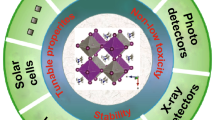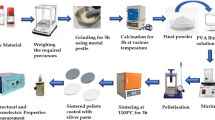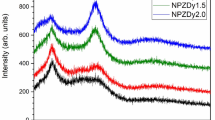Abstract
Single-phase crystalline luminophore tris(8-hydroxyquinoline) aluminum (Alq3) has been synthesized at Т = 483 K and a partial pressure of 8-hydroxyquinoline vapor from 0.15 to 6.12 Torr. The influence of P 8-Hq on the luminescent characteristics of crystalline Alq3 samples has been studied. It has been found that an increase in P 8-Hq led to a shift of the photoluminescence-band maximum and to a change in the photoluminescence-decay kinetics. It has been shown that Alq3 synthesized at Т = 483 K and P 8-Hq = 6.12 Torr had the most stable spectral-luminescent characteristics. The results obtained are discussed taking into account defect formation in crystalline Alq3.
Similar content being viewed by others
References
A. Bernanose, J. Chem. Phys. 52, 396 (1955).
C. W. Tang and S. A. van Slyke, Appl. Phys. Lett. 51, 913 (1987). doi 10.1063/1.98799
P. V. Kovtunenko, Physical Chemistry of Solid-State Materials. Defect Crystals (Vyssh. Shkola, Moscow, 1998) [in Russian].
F. A. Kroger, Chemistry of Imperfect Crystals (North- Holland, Amsterdam, 1964).
T. Tsujimura, OLED Display Fundamentals and Applications, Vol. 25 of Wiley Series in Display Technology (Wiley, New York, 2012).
I. Ch. Avetissov, A. A. Akkuzina, R. I. Avetisov, A. V. Khomyakov, and R. R. Saifutyarov, Cryst. Eng. Commun. 18, 2182 (2016). doi 10.1039/C6CE00011H
M. Brinkmann, G. Gadret, and M. Muccini, J. Am. Chem. Soc. 122, 5147 (2000). doi 10.1021/ja993608k
R. Avetisov, O. Petrova, A. Khomyakov, O. Mushkalo, A. Akkuzina, A. Cherednichenko, and I. Avetissov, J. Cryst. Growth 401, 449 (2014). doi 10.1016/j.jcrysgro. 2014.02.018
M. A. V. da Silva, M. J. S. Monte, and M. A. R. Matos, J. Chem. Thermodyn. 21, 159 (1989). doi 10.1016/0021-9614(89)90127-4
M. F. Churbanov and A. P. Vel’muzhov, Chemistry of Very Pure Inorganic Substances (Nizhegor. Gos. Univ., Nizhnii Novgorod, 2015) [in Russian].
M. Rajeswaran, T. N. Blanton, R. H. Young, and W. Brennessel, J. Chem. Crystallogr. 40, 195 (2010). doi 10.1007/s10870-009-9633-x
F. Papadimitrakopoulos, X. M. Zhang, and K. A. Higginson, IEEE J. Sel. Top. Quantum Electron. 4, 49 (1998). doi 10.1109/2944.669465
Author information
Authors and Affiliations
Corresponding author
Additional information
Original Russian Text © A.A. Akkuzina, A.V. Khomyakov, R.I. Avetisov, I.Ch. Avetissov, 2017, published in Optika i Spektroskopiya, 2017, Vol. 122, No. 4, pp. 607–610.
Rights and permissions
About this article
Cite this article
Akkuzina, A.A., Khomyakov, A.V., Avetisov, R.I. et al. The influence of synthesis conditions on the stability of tris(8-hydroxyquinoline) aluminum organometallic luminophore. Opt. Spectrosc. 122, 588–590 (2017). https://doi.org/10.1134/S0030400X17040026
Received:
Revised:
Published:
Issue Date:
DOI: https://doi.org/10.1134/S0030400X17040026




